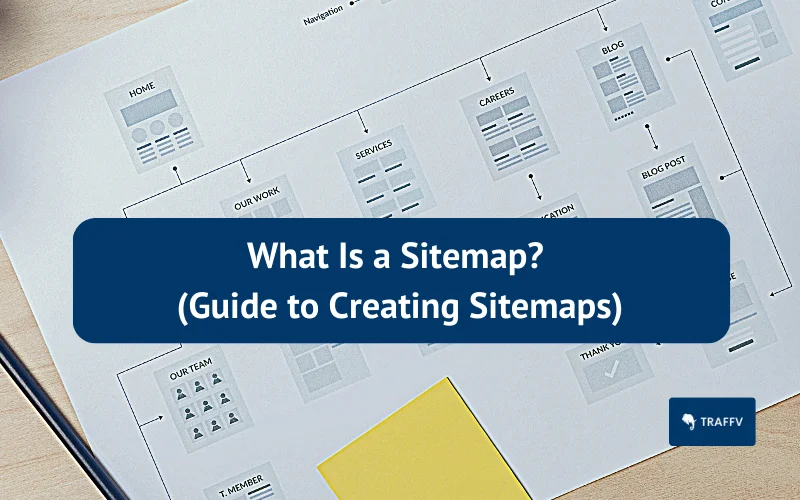Have you ever wondered how search engines like Google seem to magically discover and rank your website’s pages?
The answer lies in the power of sitemaps.
These unsung heroes of the internet play a crucial role in ensuring that your website gets the visibility and attention it deserves.
In this post, we’ll unravel the mysteries of sitemaps, explore their different types, and provide you with a comprehensive guide on creating and submitting your sitemap for optimal search engine performance.
So buckle up and get ready for a thrilling journey into the world of sitemaps!
TL:DR
- Sitemaps provide search engines and users with a structured list of URLs to improve website visibility.
- XML sitemaps facilitate faster crawling and indexing, while HTML sitemaps enable better user navigation.
- Regular updates & maintenance are essential for optimizing crawling & indexing by search engines to maximize website visibility.
Understanding Sitemaps
Sitemaps are like the blueprints of your website, allowing search engines to navigate and find pages on your site more efficiently.
They come in two main flavors: XML sitemaps and HTML sitemaps.
XML sitemaps are designed specifically for search engines, providing a list of URLs and metadata to help search engine crawlers understand the structure of your website.
On the other hand, HTML sitemaps cater to your human visitors, offering a user-friendly, organized list of links, including external links, that make it easy for them to find the content they’re looking for.
With both types of sitemaps working hand in hand, your website reaps the benefits of improved search engine visibility and enhanced user experience.
XML Sitemaps
XML sitemaps are the backbone of search engine optimization, as they provide search engines with a comprehensive list of your website’s URLs and associated metadata, such as the last modified date and priority.
This information is crucial for search engine crawlers, like Googlebot, to efficiently crawl and index your website’s pages.
By submitting a well-structured XML sitemap to search engines like Google, you’re essentially providing them with a roadmap of your website, enabling them to discover and index new and updated pages more quickly.
HTML Sitemaps
While XML sitemaps cater to search engines, HTML sitemaps serve a different purpose – enhancing your website’s navigation for your human visitors.
An HTML sitemap presents a hierarchical list of links, making it easier for users to find the content they’re looking for and explore your website in a more organized manner.
By including an HTML sitemap on your website, you’re not only improving user experience, but also providing search engines with a better understanding of your website’s architecture, which can lead to better search engine rankings.
Other Types of Sitemaps
In addition to XML and HTML sitemaps, there are also specialized sitemaps tailored to specific types of content, such as video, image, and news sitemaps.
These sitemaps cater to the unique requirements of different media formats, ensuring that your website’s content is properly indexed and easily discoverable by search engines.
One such example is the sitemap image entry, which helps in better indexing of your website’s images.
For instance, a news sitemap helps search engines like Google News quickly locate and index your website’s news articles, while a video sitemap ensures that your website’s videos are easily discoverable and properly indexed.
By customizing and submitting these specialized sitemaps, you’re further enhancing your website’s visibility and search engine performance.
The Importance of Sitemaps
Sitemaps play a pivotal role in the success of your website’s SEO, as they facilitate faster crawling and indexing by search engines, improve site navigation for users, and help search engines discover orphan pages and media that might otherwise be overlooked.
By providing search engines with a clear, organized structure of your website through a sitemap index, you’re essentially giving them a roadmap that leads to better visibility and higher rankings in search results.
In the following subsections, we’ll delve deeper into the various benefits of sitemaps and their importance in the world of SEO.
Faster Crawling and Indexing
An XML sitemap is like an open invitation for search engines to crawl and index your website’s pages.
By providing a comprehensive list of your website’s URLs and metadata in an XML file, you’re essentially streamlining the crawling process, making it faster and more efficient for search engines like Google to discover and index your pages.
This is particularly important for websites that are frequently updated or have a large number of pages, as it ensures that your new and updated content is quickly discovered and indexed by search engines.
Improved Site Navigation
An HTML sitemap is a valuable resource for your website’s visitors, as it provides them with a clear, organized list of links that make it easy to navigate your website and find relevant content.
By including an HTML sitemap on your website, you’re not only improving user experience, but also providing search engines with a better understanding of your website’s architecture, which can lead to better search engine rankings.
Ultimately, a well-crafted HTML sitemap can be the key to enhancing user engagement and driving more traffic to your website.
Enhanced Visibility for Orphan Pages and Media
Orphan pages and media are those that are not linked to from any other page or section of your website, making them difficult for users and search engine crawlers to discover.
By including these orphan pages and media in your sitemap, you’re essentially giving search engines a helping hand in locating and indexing them, thereby improving their visibility in search results.
This not only helps to ensure that all of your website’s content is properly indexed, but also contributes to a more comprehensive and engaging user experience.
Creating an SEO Optimized Sitemap
Creating an SEO-optimized sitemap is a vital step in ensuring that your website performs at its best in search engine rankings.
This involves generating XML and HTML sitemaps, as well as customizing media-specific sitemaps for video, image, and news content.
By doing so, you’re providing search engines with a comprehensive, organized view of your website, while also ensuring that your users can easily navigate and find the content they’re looking for.
In the following subsections, we’ll guide you through the process of creating and maintaining an SEO-optimized sitemap.
Generating an XML Sitemap
To generate an XML sitemap, you can use various tools or plugins, such as Screaming Frog or Yoast SEO, which automate the process and create a comprehensive list of your website’s URLs and metadata for search engines to crawl and index.
These tools can save you time and effort, ensuring that your sitemap is accurate and up-to-date, without the need for manual coding.
Once your XML sitemap has been generated, it’s important to review it manually and ensure that it meets the requirements for a valid sitemap, such as including only canonical URLs and excluding broken links.
Crafting an HTML Sitemap
Creating an HTML sitemap involves generating a user-friendly, organized list of links that make it easy for users to navigate your website.
This can be achieved using various resources, such as CMS plugins or third-party tools, which can help you craft a well-structured HTML sitemap without the need for manual coding.
It’s important to ensure that your HTML sitemap is easily accessible to users, typically by including a link to it in your website’s footer.
Additionally, make sure that the sitemap is well-organized and includes relevant descriptions for each page, making it easy for users to find the content they’re looking for.
Customizing Video, Image, and News Sitemaps
Customizing video, image, and news sitemaps involves adding specific tags and elements, such as a sitemap video entry, to cater to the unique requirements of different media formats.
This ensures that your website’s content is properly indexed and easily discoverable by search engines, improving its visibility and search engine performance.
For example, a news sitemap can be customized by adding news-specific tags, such as the publication date and article title, while a video sitemap can include video-specific elements like the video’s thumbnail URL and duration.
By tailoring your sitemaps to the specific needs of your content, you’re ensuring that your website performs at its best in search engine rankings.
Sitemap Best Practices
Adhering to sitemap best practices is essential for maximizing the effectiveness of your sitemap and ensuring optimal search engine performance.
These best practices include regularly updating and maintaining your sitemap, prioritizing high-quality content, and avoiding duplicate content and canonical issues.
By following these guidelines, you’re not only ensuring that your website’s content is properly indexed and visible in search results, but also providing an engaging and user-friendly experience for your visitors.
Regular Updates and Maintenance
Keeping your sitemap updated and well-maintained is crucial for ensuring optimal crawling and indexing by search engines.
This involves checking for broken links, updating your sitemap when new pages are added to your website, and submitting your sitemap to search engines like Google and Bing.
Regular updates and maintenance help guarantee that all content on your website is correctly indexed and discoverable by users, improving your website’s search engine performance and visibility.
Prioritizing High-Quality Content
Prioritizing high-quality content in your sitemap is essential for improving your website’s search engine rankings and user engagement.
High-quality content is characterized by being relevant, engaging, useful, well-researched, and well-written, thus meeting the expectations of the reader.
By ensuring that your sitemap includes only your best and most valuable content, you’re helping search engines understand the most important pages on your website, leading to better indexing and rankings in search results.
Avoiding Duplicate Content and Canonical Issues
Duplicate content and canonical issues can have a negative impact on your website’s search engine performance, as they can lead to confusion and indexing difficulties for search engine crawlers.
To avoid these issues, it’s important to include only canonical URLs in your sitemap, which directs search engines to the original version of a page.
By doing so, you’re ensuring that your website’s content is properly indexed and avoiding potential penalties from search engines due to duplicate content or canonical issues.
Submitting Your Sitemap to Google and Other Search Engines
Submitting your sitemap to Google and other search engines is a crucial step in ensuring that your website gets the visibility and attention it deserves.
By providing search engines with a comprehensive, organized view of your website, you’re making it easier for them to crawl and index your pages, resulting in better search engine rankings and increased visibility.
In the following subsections, we’ll guide you through the process of submitting your sitemap to Google and other search engines.
Google Search Console Submission
Submitting your sitemap to Google Search Console is a simple and effective way to ensure that your website’s pages are properly crawled and indexed by Google’s search engine.
By providing Google with your sitemap, you’re giving them a roadmap of your website, making it easier for their crawlers to discover and index new and updated pages.
Additionally, using Google Webmaster Tools can further enhance your site’s visibility and performance in search results.
To submit your sitemap, simply log in to your Google Search Console account, navigate to the “Sitemaps” report, and click the “Submit sitemap” button.
Once your sitemap has been submitted, you can monitor its status and resolve any potential issues through the “Sitemaps” report in Google Search Console.
Other Search Engine Submissions
In addition to submitting your sitemap to Google, it’s also important to submit it to other search engines like Bing and Yahoo for increased visibility and improved ranking in search engine results.
The process for submitting your sitemap to these search engines is similar to that of Google Search Console, involving logging in to their respective webmaster tools and following the submission guidelines provided.
By submitting your sitemap to multiple search engines, you’re ensuring that your website is visible to a broader audience and maximizing its potential for success in the online world.
Sitemap Generator Tools and Resources
Creating and maintaining XML and HTML sitemaps can be a time-consuming and complex process, but fortunately, there are numerous sitemap generator tools and resources available to make the task easier.
These tools automate the process of sitemap creation and maintenance, allowing you to generate sitemaps efficiently. To create a sitemap, simply choose a reliable sitemap generator and follow the instructions provided.
In the following subsections, we’ll introduce some popular sitemap generator tools and resources for creating and updating your XML and HTML sitemaps.
XML Sitemap Generation Tools
XML sitemap generation tools, such as Screaming Frog or Yoast SEO, can help you create and update your XML sitemap with ease, ensuring that it is accurate and up-to-date for search engine crawlers and web crawlers alike.
These tools not only automate the process of sitemap creation, but also provide additional features, such as validating the sitemap against any errors or issues, making them invaluable resources for website owners and SEO professionals alike.
By utilizing these tools, you can ensure that your XML sitemap meets the requirements for a valid sitemap and effectively guides search engine crawlers through your website’s content.
HTML Sitemap Creation Resources
Creating a user-friendly and organized HTML sitemap can be achieved using various resources, such as CMS plugins or third-party tools, which can help you craft a well-structured sitemap without the need for manual coding.
These resources can save you time and effort, ensuring that your HTML sitemap is easily accessible to users and provides a clear, organized list of links that make it easy for them to find the content they’re looking for.
By leveraging these resources, you can create an HTML sitemap that not only enhances user experience but also provides search engines with a better understanding of your website’s architecture.
Summary
Sitemaps play a crucial role in ensuring that your website gets the visibility and attention it deserves.
By understanding the different types of sitemaps, creating SEO-optimized sitemaps, and following best practices for sitemap creation and maintenance, you’re setting your website up for success in the competitive world of search engine rankings.
So don’t underestimate the power of sitemaps – embrace them and unlock your website’s full potential!
Engage a seo company if you need with SEO optimization!
Frequently Asked Questions
How can I create sitemap?
Creating a sitemap requires brainstorming website categories, organizing them into structures with hierarchy, adding rough written content and example images, and sketching page layouts to share with a team.
Is sitemap good for SEO?
Sitemaps are essential for good SEO, enabling search engine crawling and indexing so that website content can be ranked in search results.
What is the difference between XML and sitemap?
XML sitemaps are specifically written for search engine spiders, while HTML sitemaps are written for humans.
How to add sitemap to website?
Create an XML Sitemap by gathering your site’s URLs, coding them, and submitting to Google Search Console. Finally, click ‘Submit’ for Google to crawl the sitemap.
How often should I update my sitemap?
For optimal search engine performance, it is recommended to update your sitemap on a regular basis by checking for broken links, updating when new pages are added, and submitting your sitemap to major search engines.




